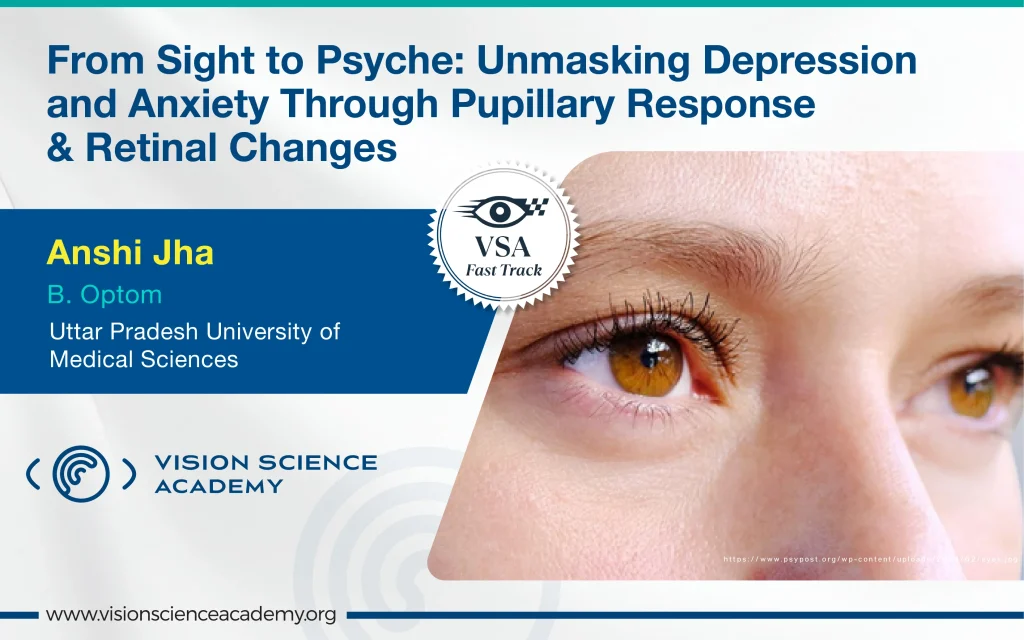Anshi Jha,
B.Optom. Student, Uttar Pradesh University of Medical Sciences, Etawah, India
Can your eyes reveal the hidden depths of your mental health? New research suggests they can. Optometry is at the intersection of a revolutionary era with psychology. (1) Increasing evidence shows that subtle changes in the eyes, like pupillary reactions, contrast sensitivity, and retinal microvasculature, may reflect underlying mental health conditions such as depression and anxiety.
This opens a new avenue for optometrists to become not just guardians of sight but observers of the psyche, aiding in the early detection of emotional and neurological disorders.
The Eye-Mind Connection: More Than What Meets the Eye
The retina and brain share a close neurobiological connection. As a part of the central nervous system, the retina reflects neurochemical changes occurring in mood disorders.
Recent studies show how depression and anxiety alter retinal activity and pupillary function, giving rise to the term “ocular biomarkers of mental illness.”
What the Eyes Reveal?
1. Reduced Pupillary Light Reflex (PLR)
People suffering from major depressive disorder (MDD) often show diminished PLR, especially under low-light conditions. This is thought to be related to dysregulation in the noradrenergic system, which plays a key role in mood. (2)
2. Contrast Sensitivity Impairment
Patients with depression or anxiety may struggle to distinguish subtle differences in shading or contrast. Research links this to dopamine pathway dysfunction in the retina. (3)
3. Retinal Vascular Abnormalities
OCT and fundus imaging reveal narrowed arterioles and reduced retinal vessel calibre in patients with chronic depression, suggesting microvascular changes similar to those seen in cardiovascular disease. (4)
Research Highlights: Bridging Optometry and Psychology
1. Pupillometry in Psychiatry (University of Illinois)
A study using infrared pupillometry revealed that patients with anxiety disorders exhibit heightened pupillary dilation in response to emotional stimuli, offering a potential objective measure for stress and arousal states. (5)
2. The Netherlands Study of Depression and Anxiety (NESDA)
This landmark study used retinal imaging to correlate retinal microvasculature changes with the severity of depressive symptoms in over 1000 participants. (4)
3. Portable Eye-Tracking Tools
Startups like NeuroTrack and MindTrace are developing eye-tracking technologies that assess fixation patterns and pupil dynamics to screen for cognitive and emotional abnormalities. (5)
Why Optometrists Matter: Detecting the Invisible
Mental health disorders often remain undiagnosed until they severely impact daily life. What if a routine eye exam could provide an early clue?
With advanced tools such as OCT, pupillometry, and contrast sensitivity charts, optometrists can play a crucial role in identifying potential mental health issues and referring patients for psychological support. (1-3)
This integrated approach aligns with the biopsychosocial model of care, which treats physical, psychological, and social aspects simultaneously. (5)
Looking Ahead: Eyes as Windows to Mental Wellness
As research expands, so does the role of eye care in neuropsychiatric diagnostics.
From academic clinics to private practices, optometry is evolving into a multidisciplinary field that may soon routinely screen for depression, anxiety, and stress, right through the eyes.
References
- Granholm, E. et al. (2017). Pupillary responses and cognitive load in major depressive disorder. Biological Psychology.
- Siegle, G. J. et al. (2001). Increased pupil dilation to emotional stimuli in depressed individuals. Biological Psychiatry.
- Demmin, D. L. & Silverstein, S. M. (2020). Visual impairments in schizophrenia and depression: A review of behavioral and neurobiological studies. Frontiers in Psychology.
- Meijer, W. M. et al. (2019). Retinal microvascular abnormalities in depression and anxiety: Results from the NESDA study. Psychological Medicine.
- NeuroTrack. (2023). Eye-Tracking for Mental Health: The New Frontier. Company white paper.
